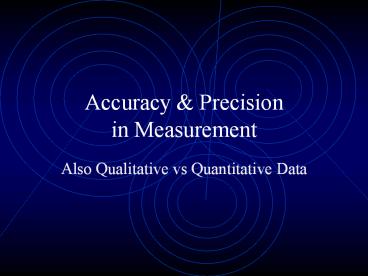Accuracy PowerPoint PPT Presentation
1 / 10
Title: Accuracy
1
Accuracy Precisionin Measurement
- Also Qualitative vs Quantitative Data
2
Accuracy Precision
- Accuracy
- How close you are to the actual value
- Depends on the person measuring
- Calculated by the formula
- Error (YV AV) x 100 AV
- Where YV is YOUR measured Value AV is the
Accepted Value
- Precision
- How finely tuned your
- measurements are or how close they can be to
each other - Depends on the measuring tool
- Determined by the number of significant digits
3
Accuracy Precision
- Accuracy Precision may be demonstrated by
shooting at a target. - Accuracy is represented by hitting the bulls eye
(the accepted value) - Precision is represented by a tight grouping of
shots (they are finely tuned)
4
Accuracy without Precision
Accuracy Precision
No Precision No Accuracy
Precision without Accuracy
5
Accuracy - Calculating Error
- How Close Are You to the Accepted Value (Bulls
Eye)
6
Accuracy - Calculating Error
- If a student measured the room width at 8.46 m
and the accepted value was 9.45 m what was their
accuracy? - Using the formula error (YV AV) x 100 AV
- Where YV is the students measured value AV is
the accepted value
7
Accuracy - Calculating Error
- Since YV 8.46 m, AV 9.45 m
- Error (8.46 m 9.45 m) x 100 9.45 m
- -0.99 m x 100 9.45 m
- -99 m
9.45 m - -10.5
- Note that the meter unit cancels during the
division the unit is . The (-) shows that YV
was low - The student was off by almost 11 must
remeasure - Acceptable error is within 5
8
- Acceptable error is /- 5
- Values from 5 up to 5 are acceptable
- Values less than 5 or greater than 5 must be
remeasured
9
Data
- Data is information gathered during experiences
(whether its when you walk into a room or during
an experiment, we are constantly gathering data.) - Data is either qualitative or quantitative.
10
Quantitative Data
- Measurements (uses numbers and units)
- Not descriptive
11
Qualitative Data
- Descriptive information taken (such as color,
taste, or personal opinion) uses words - NOT measurements
12
(No Transcript)
13
Significant Digits
- How to Check a Measurement for Precision
14
Significant Digits Precision
- The precision of a measurement is the smallest
possible unit that could be measured. - Significant Digits (sd) are the numbers that
result from a measurement. - When a measurement is converted we need to make
sure we know which digits are significant and
keep them in our conversion - All digits that are measured are significant
15
Significant Digits Precision
- What is the length of the bar?
- How many digits are there in the measurement?
- All of these digits are significant
- There are 3 sd
Length of Bar 3.23 cm
16
Significant Digits Precision
- If we converted to that measurement of 3.23 cm to
mm what would we get? - Right! 32 300 mm
- How many digits in our converted number?
- Are they all significant digits (measured)?
- Which ones were measured and which ones were
added because we converted? - If we know the significant digits we can know the
precision of our original measurement
17
Significant Digits Precision
- What if we didnt know the original measurement
such as 0.005670 hm. How would we know the
precision of our measurement. - The rules showing how to determine the number of
significant digits is shown in your lab manual on
p. 19. Though you can handle them, they are
somewhat complex.

